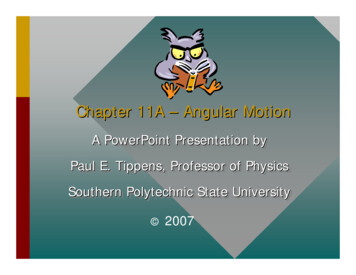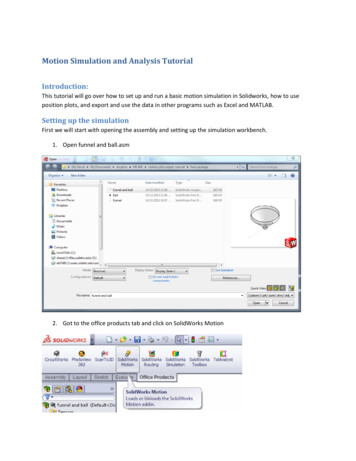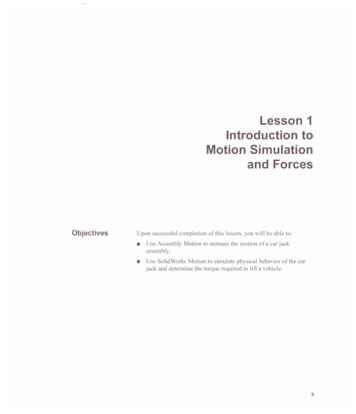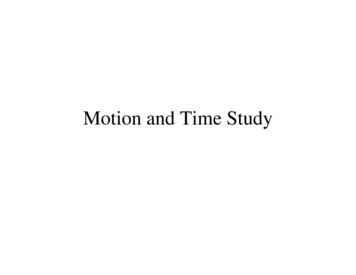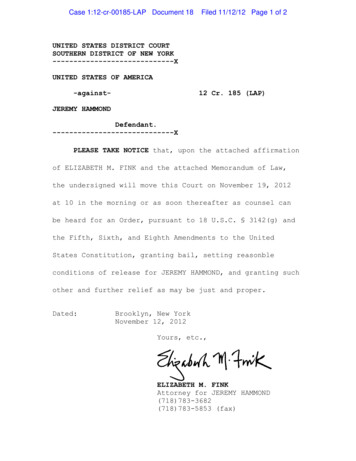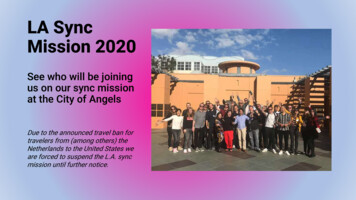
Transcription
Chapter 5. Force and MotionIn this chapter we studycauses of motion: Why doesthe windsurfer blast acrossthe water in the way hedoes? The combined forcesof the wind, water, andgravity accelerate himaccording to the principlesof dynamics.Chapter Goal: To establisha connection between forceand motion.Copyright 2008 Pearson Education, Inc., publishing as Pearson Addison-Wesley.
Chapter 5. Force and MotionTopics: Force A Short Catalog of Forces Identifying Forces What Do Forces Do? Newton’s Second Law Newton’s First Law Free-Body DiagramsCopyright 2008 Pearson Education, Inc., publishing as Pearson Addison-Wesley.
Force: Properties1. Push or Pull2. Acts on an object3. Force is a vector4. Force is either a contact force or long range force3Copyright 2008 Pearson Education, Inc., publishing as Pearson Addison-Wesley.
Force: PropertiesForce is a vector – The net force is the vector sum of theindividual forcesHow can we find the individual force?4Copyright 2008 Pearson Education, Inc., publishing as Pearson Addison-Wesley.
Major Forces:1. Weight – gravitational forcepulls the objects down – determines its directionmagnitude:rrw mgm- Mass of the objectmg 9.8 2s- free-fallacceleration5Copyright 2008 Pearson Education, Inc., publishing as Pearson Addison-Wesley.
Major Forces:1. Weight – gravitational forcerrw mgFsp kx2. Spring Forcekx- coefficient, which dependsonly on geometric parametersof the spring l - change in the length of the spring6Copyright 2008 Pearson Education, Inc., publishing as Pearson Addison-Wesley.
Major Forces:1. Weight – gravitational force2. Spring ForceFsp kx3. Tension ForcerTrrw mgdirection is always in the direction of the ropemagnitude - usually found from the condition of equilibrium7Copyright 2008 Pearson Education, Inc., publishing as Pearson Addison-Wesley.
Major Forces:rr1. Weight – gravitational force w mg2. Spring Force Fsp kxr3. Tension Force Tr4. Normal Force ndirection is always perpendicular to the surfacemagnitude - usually found from the condition of equilibrium8Copyright 2008 Pearson Education, Inc., publishing as Pearson Addison-Wesley.
Major Forces:1. Weight – gravitational force2. Spring ForceFsp kx3. Tension Force nr4. Normal Force5. Frictionrrw mgrTrfkr- Kinetic friction – opposes the motionfsdirection – opposite the velocity vector- static friction – prevent the motion of the objectdirection – opposite the direction in which the object wouldmove9Copyright 2008 Pearson Education, Inc., publishing as Pearson Addison-Wesley.
Major Forces:1. Weight – gravitational forcerrw mg2. Spring Force Fsp kxr3. Tension Force Tr4. Normal Force n5. Frictionr- kinetic friction f kr- static frictionfs10Copyright 2008 Pearson Education, Inc., publishing as Pearson Addison-Wesley.
Force IdentificationrnrnrTrfsrrw mgrfkrrw mg11Copyright 2008 Pearson Education, Inc., publishing as Pearson Addison-Wesley.
Free-Body Diagram1) Object – as a particle2) Identify all the forces3) Find the net force (vector sum of all individual forces)4) Find the acceleration of the object (second Newton’s law)5) With the known acceleration find kinematics of the object12Copyright 2008 Pearson Education, Inc., publishing as Pearson Addison-Wesley.
Newton’s Laws of MotionIt was Isaac Newton(1642-1727) who realizedthe importance of forceand its connection withmotion.Three Laws of motion 1st Law: inertia 2nd Law: change inmotion 3rd Law: action andreaction pairsCopyright 2008 Pearson Education, Inc., publishing as Pearson Addison-Wesley.
About NewtonIn 1665, shortly after getting a bachelor’s degree at Cambridge, Newton wasforced to return to his home because of the Great Plague. During the next 18months he formulated most of his scientific discoveries: including, thedevelopment of his three Laws of motion, the Law of gravitation, theinvention of the calculus, the dispersion of light, the building of a reflectingtelescope, and so on. That short period was probably the most creativeperiod in the history of man . and it will never be repeated!Newton’s book of 1687:the Principia MathematicaCopyright 2008 Pearson Education, Inc., publishing as Pearson Addison-Wesley.
Newton’s Second LawAn object of massm subject to forcesr rF1 , Fwill2 , .undergo an acceleration given byrr Fneta mrnrTr r r rr w n T fka mrfkrrw mgCopyright 2008 Pearson Education, Inc., publishing as Pearson Addison-Wesley.15
Newton’s Second Lawrr Fneta mr r r rr w n T fka mrnrTIt is convenient to introducecoordinate system and write theNewton’s second law in terms ofvector componentsyxrfkrrw mgNo motion in y-direction:ay 0wy n 0For motion in x-direction:ma x w x T f kCopyright 2008 Pearson Education, Inc., publishing as Pearson Addison-Wesley.16
Free-fall motionrrw mgThen from the secondNewton’s law:rrr w mg ra gmmmg 9.8 2sThe acceleration is the same for allobjects (does not depend on the massof the object)17Copyright 2008 Pearson Education, Inc., publishing as Pearson Addison-Wesley.
Newton’s First LawAn object that is at rest will remain at rest, or an object thatis moving will continue to move in a straight line withconstant velocity, if and only if the net force acting on theobject is zero.rFnet 0 thenStatic equilibriumra 0 velocity isconstantDynamic equilibrium18Copyright 2008 Pearson Education, Inc., publishing as Pearson Addison-Wesley.
Inertial reference framesInertial reference frame is the coordinate system in whichNewton’s laws are valid.The earth is an inertial reference frameAny other coordinate systems, which are traveling with constantvelocity with respect to the earth is an inertial reference frameCar traveling with constant velocity is an inertial referenceframeCar traveling with acceleration is NOT an inertial referenceframe (violation of Newton’s law)19Copyright 2008 Pearson Education, Inc., publishing as Pearson Addison-Wesley.
Copyright 2008 Pearson Education, Inc., publishing as Pearson Addison-Wesley.
Chapter 5. SummaryCopyright 2008 Pearson Education, Inc., publishing as Pearson Addison-Wesley.
22Copyright 2008 Pearson Education, Inc., publishing as Pearson Addison-Wesley.
Chapter 5. QuestionsCopyright 2008 Pearson Education, Inc., publishing as Pearson Addison-Wesley.
Two of three forces exerted on an object areshown. The net force points to the left. What isthe missing third force?Copyright 2008 Pearson Education, Inc., publishing as Pearson Addison-Wesley.
Two of three forces exerted on an object areshown. The net force points to the left. What isthe missing third force?Copyright 2008 Pearson Education, Inc., publishing as Pearson Addison-Wesley.
You’ve just kicked a rock, and it is nowsliding across the ground about 2 metersin front of you. Which of these forces acton the ball?A. Gravity, acting downwardB. The normal force, acting upwardC. The force of the kick, acting in thedirection of motionD. Friction, acting opposite the direction ofmotionE. A, B, and D but not C.Copyright 2008 Pearson Education, Inc., publishing as Pearson Addison-Wesley.
You’ve just kicked a rock, and it is nowsliding across the ground about 2 metersin front of you. Which of these forces acton the ball?A. Gravity, acting downwardB. The normal force, acting upwardC. The force of the kick, acting in thedirection of motionD. Friction, acting opposite the direction ofmotionE. A, B, and D but not C.Copyright 2008 Pearson Education, Inc., publishing as Pearson Addison-Wesley.
Two rubber bands stretched the standarddistance cause an object to accelerate at2 m/s2. Suppose another object with twicethe mass is pulled by four rubber bandsstretched the standard length. Theacceleration of this second object isA. 16 m/s2.B. 8 m/s2.C. 4 m/s2.D. 2 m/s2.E. 1 m/s2.Copyright 2008 Pearson Education, Inc., publishing as Pearson Addison-Wesley.
Two rubber bands stretched the standarddistance cause an object to accelerate at 2m/s2. Suppose another object with twice themass is pulled by four rubber bandsstretched the standard length. Theacceleration of this second object isA. 16 m/s2.B. 8 m/s2.C. 4 m/s2.D. 2 m/s2.E. 1 m/s2.Copyright 2008 Pearson Education, Inc., publishing as Pearson Addison-Wesley.
Three forces act on an object. In whichdirection does the object accelerate?Copyright 2008 Pearson Education, Inc., publishing as Pearson Addison-Wesley.
Three forces act on an object. In whichdirection does the object accelerate?Copyright 2008 Pearson Education, Inc., publishing as Pearson Addison-Wesley.
An elevator suspended by a cable ismoving upward and slowing to a stop.Which free-body diagram is correct?Copyright 2008 Pearson Education, Inc., publishing as Pearson Addison-Wesley.
An elevator suspended by a cable ismoving upward and slowing to a stop.Which free-body diagram is correct?Copyright 2008 Pearson Education, Inc., publishing as Pearson Addison-Wesley.
Title: Microsoft PowerPoint - Chapter5 [Compatibility Mode]



